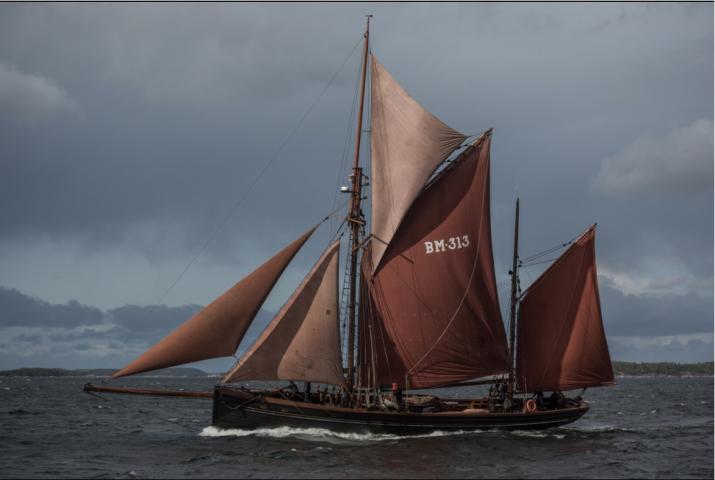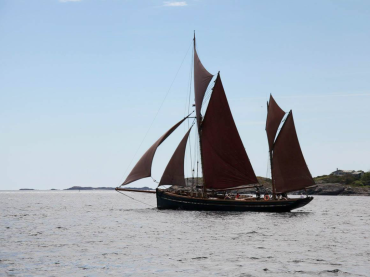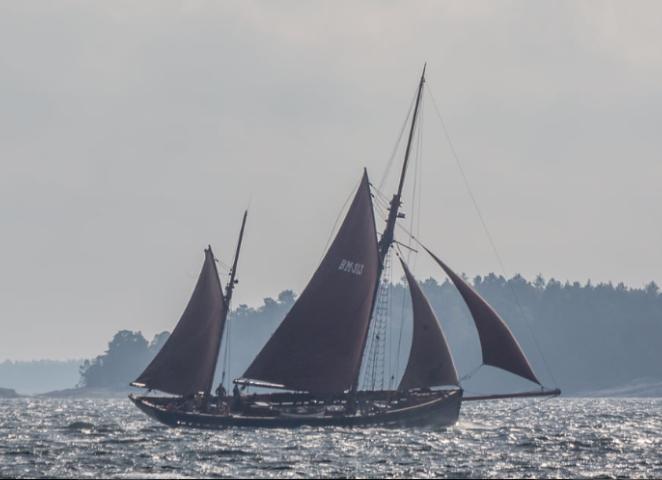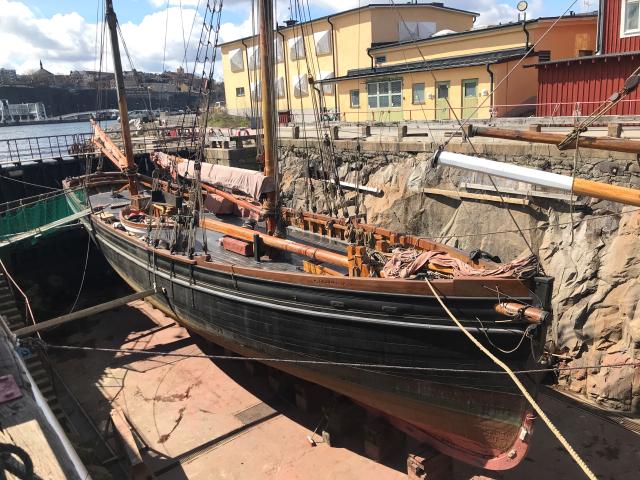Previous names
- 1911 - 1942 DEODAR
- 1942 - 1962 RIGMOR
Details
Construction
Dimensions
History
DEODAR was built as a sailing trawler at the Robert Jackman & Sons shipyard in Brixham, Devon, in 1911. She was ordered by Henry and Edward Hellings fish chandlers in Milford Haven and rigged as a ketch, with a standard rig for the Bristol Channel of 35 feet between deck and hounds on the main mast. She was assigned the fishing number BM 313 and, since she registered over 40 gross tonnage, was therefore considered by the locals "a big sloop". The fishing equipment included an approximately 48 foot beam trawl as well as a steam driven capstan of the brand Elliot & Garrood. There was no motor onboard and the crew consisted of four men, a skipper, 1st and 2nd mate and a deckhand.
DEODAR trawled in the Bristol Channel and along the western and southern coasts of England and Wales. The catches were probably landed in various fishing ports such as Isle of Man, Milford, Fleetwood, Fishguard, Padstow, Newlyn, Plymouth and Brixham and consisted of Atlantic cod, whiting, etc.
The first years of the 20th century up until the First World War were the most prosperous ever for Brixham, but the war meant catastrophe for the sailing fleet. German U-boats diminished the number of commercial and fishing vessels. In June 1919 DEODAR was sold to Lowestoft on the east coast and registered as LT 543. The new owners were the company Slater & Barnard, whose fleet consisted of twenty-two sailing trawlers.
In Spring 1937 DEODAR was sold again, to John Harald Heimer of Grundsund, Sweden. DEODAR was registered and measured according to Swedish requirements and certified as a Swedish owned vessel with the Reg. No 8180. However, the depression created difficulties in finding a new owner, so DEODAR was left idle for a few years. In efforts to find a new purchaser, Heimer had a one cylinder, 50 horse power, oil Avance engine installed. Re-measured, DEODAR was then used as an auxiliary sailing vessel. In spite of this modernisation it took approximately five years for DEODAR to get back into commission after arriving in Sweden.
In December 1941 DEODAR was sold to Karl Albert Johansson and his son Sven Osvald. The new owners felt that the name DEODAR would be difficult to pronounce so renamed her RIGMOR. During the spring of 1942 she was refitted as a cargo vessel. This involved the building of a cargo hold, a wheel house and the replacement of the tiller with a steering wheel. This work was carried out by Oskar Svenningsson at the Knippla Shipyard.
In April 1942 RIGMOR was classed as a trading vessel with her home port in Hamburgsund on the Swedish west coast. From here on followed seventeen very prosperous years as a cargo ship, mostly carrying ice, which was loaded onboard in Friesfjorden near Oslo. The ice was sawn and loaded onboard in 100 kilo blocks, then shipped to some of the fishing harbours on the Swedish west coast. Other types of cargo included saltpeter for the production of fertiliser, soda, and nitric acid in glass jars placed on deck, all for farming use. As return freight, wheat was taken onboard and delivered to the Carnegie Brewery in Gothenburg. 1958 saw the end of trading activities for RIGMOR.
On the 18th of February 1959 RIGMOR was sold to Kurt Järdving to be used as a pleasure yacht with a new home port in Gothenburg. Ownership changed several times during the following years. Architect Nils Jacobsson and his wife Lily used her for five seasons for family holidays along the quiet bays of the Swedish coast. The interior was refurbished and made more suitable as a pleasure yacht and she was given a new set of sails. The hull was painted blue and the 1 cylinder oil engine was exchanged for a modern 6 cylinder diesel engine. In March 1962 she was renamed her original name of DEODAR.
On 25th March 1964 DEODAR was sold to Anders Nilsson in Malmo. She was fitted out for a long trip to the Mediterranean starting in 1965. Unfortunately the trip ended in Danish waters, due to a broken gear box. The project was abandoned and the vessel for sale once again.
On 1st May 1966 Hans Petersson of Malmö became the new owner and began fitting Deodar out for a journey south to warmer waters. A crew of four left Sweden in the spring of 1967. After some initial problems with the new transmission, which had replaced the broken down gearbox, they continued through the Kiel Canal towards the North Sea coast. However, the journey ended at Le Havre in northern France. On the return trip the topmast broke due to the force put on it by the big balloon jib.
During the remainder of the season DEODAR was engaged in daily diving excursions from Landskrona, and was then laid up for the winter. On 27th March 1968 a fire broke out on board and the insurance company decided that the damage was so great that she was considered a total loss and should be broken up. However, the Sea Scouts of Malmö found the derelict vessel and decided to rebuild DEODAR into a sail training vessel. Restoration works took place at their Limhamn harbour headquarters; the hull was cleaned and 15 tons of new iron ballast was taken on board. A new interior was built and the engine was checked. The wheelhouse was removed in the summer of 1971 leaving only the lower deckhouse intact and the steering now out in the open air. However, after more than three years of intensive work, the club eventually decided to give up the project and DEODAR was put out for sale in the spring of 1972.
On 26th March, 1972, DEODAR was purchased by a new Sailing Ship Association formed by its ten owners in Malmö. This group of friends fitted out the vessel for short weekend trips and summer holidays along the coast. By the autumn of 1973 the ownership was reduced to two owners. A restoration project with an historical outlook was planned. The deckhouse and the steering wheel were done away with. A new bowsprit and top-mast were set up and the vessel's appearance reverted to the original English design.
By 1976, Stockholm became the new home port. Long holiday trips, stretching along all the coasts of Sweden, Denmark and Norway were carried out each summer. A better engine was installed in 1978. Better sails were fitted and natural fibre in the rig and sails gave way to synthetic materials.
In the spring of 1979 Thomas Hellström became sole owner and carried out various restoration projects. Frames and planks were changed step by step beginning in 1981. In 1983 she spent six months on the slipway and had a new stem and stern timbers, as well as new frames and planking. The sheer lines were improved and the keel was supported by an iron girder. Major hull restorations continued during the winter of 1986-87 when the remainder of the double 5" top-timbers in frames, and 2 1/2" - 3” planking above water line were renewed, all in oak. In addition to this all of the stanchions were made new as was the bulwark. These restoration works were carried out in the Western Dry Dock on the island of Beckholmen, Stockholm. At this point in time the Swedish Sailing Ship Association founded the Historical Shipyard in the centre of Stockholm.
Further major shipyard restoration works included, in 1989 - 90: frames and planking under the water line were renewed to a great extent. The inside planking in 2" fir was also renewed as well as the entire interior outfit. In 1992 - 93 a new deck was laid, including, shelves, beams, deck-planks and hatches etc. Masts and spars were overhauled and the sails and running rigging were looked over. DEODAR continued to sail every summer while these major works to the hull and rig and outfit were being done.
In the summer of 1996 DEODAR made her first trip back to England. Old home ports such as Brixham and Lowestoft were revisited for the first time since she was sold to Sweden in 1937. DEODAR also attended the Maritime Festival in Brest during this 10 week cruise. During 1998 and 1999, DEODAR participated in Nordic sailing regattas organised between Sweden, Norway and Denmark. A new second hand engine was installed during the winter dry dock period 2000- 2001, the propeller overhauled and and new framing and planking carried out under water line.
In 2000 and 2003, DEODAR participated in the Tall Ships Races which took place in the Baltic Sea. In 2005, she returned to England, this time with sister ship SUNBEAM, an ex UK Sailing Trawler built in Lowestoft 1905, which had also been restored in the historical shipyard of Stockholm. In 2007, DEODAR once again participated in the Tall Ships Race in the Baltic as well as Hanse Sail Rostock the same year. In 2008 DEODAR was struck by fire and thus underwent another major refit and total makeover of parts of the deck and stern in 2009-10.
2015 brought yet a third visit back to England and Wales. This trip lasted for eleven weeks and involved a Sailing Trawler race in Arendal, Norway as well as a North Sea passage to Scotland. DEODAR travelled through Scotland via the Caledonian Canal and down to the English and Welsh coasts where she visited various harbours including the Isle of Man, Fleetwood, Liverpool, Fishguard and Milford Haven. Milford had been the vessel's home port during 1911-1919 where she trawled under sail in the Bristol Channel and the Irish Sea for Hellings fish merchants. Many other harbours were visited including Padstow, Newlyn and Falmouth, Plymouth, Dartmouth and finally Brixham, her place of build. In Brixham the owners met up with some other Brixham trawlers including PILGRIM OF BRIXHAM and VIGILANCE. The trip continued along the English Channel to Weymouth, Isle of Wight and Brighton until Lowestoft was reached in beginning of August.
The DEODAR continues to sail every summer, proving the good workmanship of Brixham's extraordinary shipbuilding tradition, linking back to the days of working sail from more than 100 years ago. She is also part of the Cultural Heritage of Sweden, one of the jewels of the Swedish traditional fleet, and is a testament to her long term owner who rebuilt the vessel and has kept her up to a very high standard ever since.
As of May 2024, the vessel is for sale.
Key dates
-
1911
Built as sailing trawler BM 313 at the Robert Jackman & Sons shipyard in Brixham, Devon for J & E J Hellings of Milford Haven
-
1919
Purchased by Slater & Barnard of Lowestoft and relocated there
-
1937
Purchased by J.H. & C.A. Heimer of Grundsund, Sweden and relocated there
-
1941
Purchased by K.A. & O.J. Johansson of Grundsund, Sweden, who renamed her RIGMOR and relocated to Hamburgsund, Sweden
-
1959
Purchased by K Järdving to be used as a pleasure yacht and relocated to Gothenburg, Sweden
-
1962
Renamed DEODAR
-
1964
Purchased by A Nilsson of Malmö, Sweden
-
1966
Purchased by H Petersson of Malmö, Sweden
-
1968
A fire broke out on board and DEODAR was considered a total loss and to be broken up. However, the Sea Scouts of Malmö found the derelict vessel and decided to rebuild her into a sail training vessel. Restoration works took place at their Limhamn harbour headquarters for several years until she was considered to be too much work and was put up for sale
-
1972
Purchased by a new Sailing Ship Association formed of ten members in Malmö, Sweden. In 1973, the ownership of the vessel was reduced to two of the ten original members, T Hellström & R Sandin
-
1976
Home port relocated to Stockholm, Sweden
-
1979
Sole ownership of the vessel to T Hellström, her current owner. Over the following years he has carried out various restoration projects
-
2008
DEODAR was struck by fire and thus underwent another major refit and total makeover of parts of the deck and stern in 2009-10
Own this vessel?
If you are the owner of this vessel and would like to provide more details or updated information, please contact info@nationalhistoricships.org.uk








